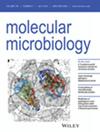Multifaceted Evolution of the PhoPQ Two-Component System in Salmonella enterica Enhanced the Expression of Horizontally Acquired Virulence Genes
IF 2.6
2区 生物学
Q3 BIOCHEMISTRY & MOLECULAR BIOLOGY
引用次数: 0
Abstract
For a bacterium to adapt to a new environmental niche, its regulatory networks must evolve to effectively sense and respond to cues within that niche. For bacterial pathogens, which encounter harsh and dynamic host niches that require efficient coordination between detecting host cues and regulating virulence genes, this process is a key aspect of how virulence properties evolve. Here, we investigate how a widely conserved two-component regulatory system (TCS), PhoP/PhoQ (PhoPQ), evolved in Salmonella enterica to adopt a new role as a master regulator of gene expression within its species-specific intracellular niche: the Salmonella-containing vacuole (SCV). By comparing Salmonella PhoPQ with the closely related Escherichia coli PhoPQ ortholog, we demonstrate that optimizing virulence gene expression in Salmonella required a multifaceted evolution of several PhoPQ functional domains and establish that distinct genetic differences and mechanisms enhance virulence gene expression for different inducing cues. Interestingly, we find that the increased activity of the Salmonella PhoPQ system has a much more profound impact on the expression of H-NS-repressed, horizontally acquired virulence genes than on the ancestral members of the PhoP regulon. We observe that the PhoPQ systems of other related bacteria exhibit activity levels similar to the E. coli system, suggesting that the differences we observe are the result of Salmonella-specific adaptations that produced a more active PhoPQ system when encountering SCV conditions. Collectively, this study offers a window into the evolutionary adaptations of a TCS that enable it to assume an expanded regulatory role in a unique environment.

肠道沙门氏菌PhoPQ双组分系统的多面进化增强了水平获得毒力基因的表达
细菌要适应新的环境利基,其调节网络必须进化到能够有效地感知和响应利基中的信号。对于细菌病原体,它们遇到严酷和动态的宿主生态位,需要在检测宿主线索和调节毒力基因之间进行有效的协调,这一过程是毒力特性如何进化的关键方面。在这里,我们研究了广泛保守的双组分调控系统(TCS) PhoP/PhoQ (PhoPQ)是如何在肠沙门氏菌中进化成为其物种特异性细胞内生态位:含沙门氏菌液泡(SCV)中基因表达的主要调节剂的。通过比较沙门氏菌PhoPQ与相近的大肠杆菌PhoPQ同源物,我们发现沙门氏菌中毒力基因表达的优化需要多个PhoPQ功能域的多方面进化,并确定了不同的遗传差异和机制在不同的诱导线索下增强毒力基因表达。有趣的是,我们发现沙门氏菌PhoPQ系统活性的增加对h - ns抑制的水平获得毒力基因的表达的影响比PhoP调控子的祖先成员要深远得多。我们观察到其他相关细菌的PhoPQ系统表现出与大肠杆菌系统相似的活性水平,这表明我们观察到的差异是沙门氏菌特异性适应的结果,当遇到SCV条件时,沙门氏菌产生了更活跃的PhoPQ系统。总的来说,这项研究为TCS的进化适应提供了一个窗口,使其能够在独特的环境中承担更大的调节作用。
本文章由计算机程序翻译,如有差异,请以英文原文为准。
求助全文
约1分钟内获得全文
求助全文
来源期刊

Molecular Microbiology
生物-生化与分子生物学
CiteScore
7.20
自引率
5.60%
发文量
132
审稿时长
1.7 months
期刊介绍:
Molecular Microbiology, the leading primary journal in the microbial sciences, publishes molecular studies of Bacteria, Archaea, eukaryotic microorganisms, and their viruses.
Research papers should lead to a deeper understanding of the molecular principles underlying basic physiological processes or mechanisms. Appropriate topics include gene expression and regulation, pathogenicity and virulence, physiology and metabolism, synthesis of macromolecules (proteins, nucleic acids, lipids, polysaccharides, etc), cell biology and subcellular organization, membrane biogenesis and function, traffic and transport, cell-cell communication and signalling pathways, evolution and gene transfer. Articles focused on host responses (cellular or immunological) to pathogens or on microbial ecology should be directed to our sister journals Cellular Microbiology and Environmental Microbiology, respectively.
 求助内容:
求助内容: 应助结果提醒方式:
应助结果提醒方式:


